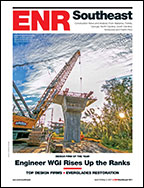As industry firms balance management of global talent and bottom-line costs, human resource managers are gaining more visibility in design and construction executive suites, along with their growing workforce challenges.
According to a new survey and a May 15 gathering in New York City of industry HR professionals, managers are seeking new strategies to cope with everything from compensation for CEOs to the cost of the Affordable Care Act, also known as Obamacare.
In a survey released at its fifth annual HR conference, industry financial consultant EFCG outlined compensation and workforce practice trends. CEOs of large firms above $500 million in revenue earned 60% of their pay from long-term compensation, with salary comprising 19% and cash bonus 22%, says the survey.
Small and mid-sized firm CEOs gained 62% of earnings from salary, with bonuses making up 29% and long-term pay only 9%, says EFCG.
The survey was based on data from 95 design and construction firms, including some based outside the U.S., with respondents representing nearly 600,000 employees and $182 billion in 2013 gross revenue.
According to results, compensation of officers and vice presidents correlated with level of revenue responsibility, but EFCG survey manager Joe Smetona told the 90 professionals that it was puzzling why there was little salary difference for those with less than 15 years of experience.
Diversity remains a challenge. While women make up between 32% and 36.7% of surveyed company ranks, proportions of minorities varied widely by firm revenue. They comprise 21% of staffs in companies between $250 million and $1 billion but only 9.8% in those under $100 million.
But EFCG data indicate that diversity is on an upward swing in 2014 from the past three years, said Smetona.
He said in firms where women made up more than 40% of staff, profitability was highest, averaging 12.1%.
Firms also noted current and anticipated impacts from changes in health care delivery to employees related to health care reform. Respondents said their median cost of plans will rise 4% in 2014, with firms budgeting about 8% more to cover rising expenses and with employee median cost hikes at 33%.
Nearly two-thirds of survey respondents have redesigned health plans to offset added costs and 44% have shifted costs to employees.
Mark Gundacker, human resources vice president for the Oregon-based Americas unit of Australian engineer Cardno, said it has removed numerous free options from its benefits plans.
With more firms working globally, the survey noted that 66% of responding firms say they have a written policy for internationally assigned staff, and 71% say they "tax-equalize" them.
Related to length of overseas assignments, about 2% of respondents report that employees serve as expatriates for one year; with 8% noting five-year assignments, 31% allowing staff to be in expatriate satus until the end of a project and 14% saying the assignment status is "indefinite."
John Sanders, director of global total rewards for Black & Veatch, said the firm is dealing with escalating expatriate costs on projects that impact bids, particularly in emerging economies.
With growing client pressure to use local forces, the firm has partnered with an international consultant to provide benchmarking data on benefits providers in countries the firm is targeting.
"This helps especially when we win a project and have to place employees at a moment's notice," he said. "And we're not dependent on local management to determine benefits providers and costs.






Post a comment to this article
Report Abusive Comment